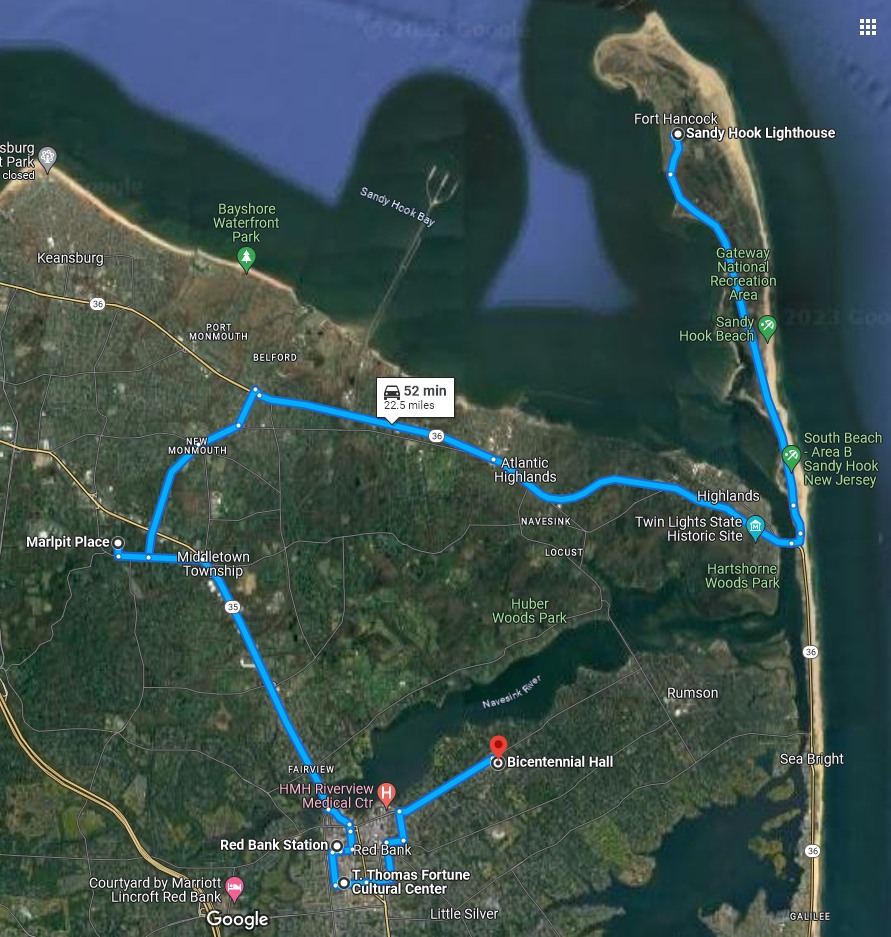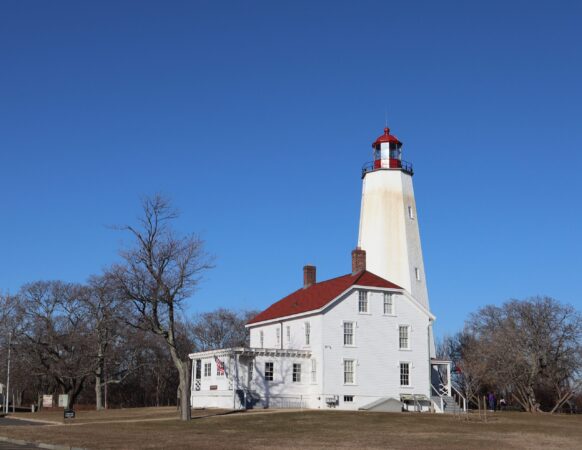Lighthouses have been aiding navigators for more than 2,000 years. The first lighthouse in America was the Boston Light, built in 1716 at Boston Harbor. Sandy Hook Lighthouse was the fifth lighthouse built in the United States, but it is one of the only early American lighthouses that was never rebuilt. Since the original lighthouse from 1764 is still in use, Sandy Hook Lighthouse is the oldest operating lighthouse in the country. (editor’s note: Sandy Hook Lighthouse is located at 84 Mercer Road, Sandy Hook, there is limited parking nearby but during the summer season visitors may have to park a little farther away. There is a museum that is open during the season.)
Since the dawning of the colonial era, ships seeking to enter New York Harbor had to access the channels of the New York Bight, a natural offshore geological depression along the coast of New York and New Jersey. Entering the harbor this way took ships very close to the tip of Sandy Hook.
But it could be a precarious crossing. As commercial shipping increased, there was a period of several years of especially treacherous shipwrecks on the unpredictable shifting unseen sandbars and shoals surrounding Sandy Hook. In response, New York merchants petitioned the Colonial Assembly of New York in 1761 to build a lighthouse on Sandy Hook. The New York Assembly supported this proposal and passed “An Act for raising a Sum not to exceed Three Thousand Pounds by way of a Lottery for building a Light House” on Sandy Hook.
A committee of prominent New York citizens was authorized to establish the lottery and purchase “a small quantity of land” at the tip of Sandy Hook to build a lighthouse. Negotiations with Robert and Esek Hartshorne, the owners of Sandy Hook, resulted in the purchase on May 16, 1762, of four acres of “barren, sandy soil… for the moderate price of 750 pounds.”
To pay for the operation and maintenance of the new lighthouse, the Colony of New York authorized a tonnage tax of three pence per ton on ships sailing into the harbor. This enabled the Port of New York to maintain the lighthouse, pay a keeper’s salary, and make a small profit from any surplus tax money.
The June 18, 1764 edition of the New York Mercury reported that, “On Monday Evening last June 11, 1764, the NEW-YORK LIGHT HOUSE erected at Sandy Hook was lighted for the first Time. The House is of an Octagonal Figure, having eight equal Sides; the diameter at the Base, 29 Feet; and at the Top of the Wall, 15 Feet. The Lanthorn (lantern house) is 7 Feet high; the Circumference 33 feet. The whole Construction of the Lanthorn is Iron; the Top covered with Copper. There are 48 Oil Blazes. The Building from the Surface is Nine Stories; the whole from Bottom to top, 103 feet.”
In 1764, the lighthouse stood just 500 feet from the tip of Sandy Hook. Over the years, gulf stream currents moved sand from New Jersey beaches northward, up the coast, building up and extending the tip of Sandy Hook further out into the harbor, so that by 1864, the lighthouse stood about 4,000 feet from the tip. The lighthouse now stands about one and one half miles from the northern end of Sandy Hook.
Refugeetown
During the Revolutionary War, the British controlled the entrances to New York Harbor, including Staten Island and Sandy Hook. Over the course of the war, Monmouth County’s Patriots were able to assert themselves and drive out avowed Loyalists, many of whom joined American volunteer militia units attached to the British Army, such as the Queen’s American Rangers.
As the civil war in Monmouth County raged, Loyalists increasingly fled to the safety of Sandy Hook. A tent community of sorts arose around the lighthouse, comprised of former white landowners, escaped slaves, Black freedmen, and others who felt they needed protection. This eventually became known as “Refugeetown.” In this group was an escaped slave from Colts Neck named Colonel Tye, who led a group of Blacks and whites called the “Black Brigade” on raids into Monmouth County, seeking forage, supplies, weapons and ammunition, and prominent citizens who could be taken prisoner and exchanged for Loyalist and British prisoners of war. This sparked fears among Patriots of a slave rebellion, leading to even more harsh limits and punishments that restricted movement among Black people.
On June 11, 1964, the Sandy Hook Lighthouse was declared a National Historic Landmark on the 200th anniversary of its first lighting. The light is currently an automated 3rd order Fresnel lens, fixed white light, visible for 19 miles on clear nights. The light is maintained by the United States Coast Guard and is kept on 24 hours a day.
BLACK HISTORY TRAIL: Click here to see Day One, Stop Two, Marlpit Hall.

SOURCES:
The Sandy Hook Lighthouse. National Park Service, U.S. Department of the Interior, Gateway National Recreation Area, Sandy Hook Unit. Available: www.nps.gov/gate/learn/historyculture/upload/SAHOLightBull-13August2015_rev9April2018.pdf
United States Lighthouse Society: Available: uslhs.org/education/glossaries-facts-trivia/lighthouse-facts
Photo credit: John R. Barrows


I never knew any of this. Fascinating